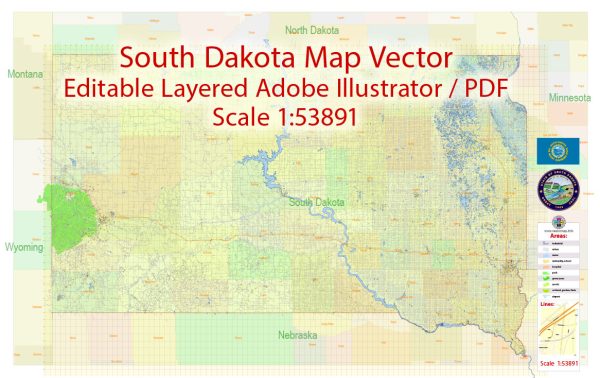South Dakota is a state located in the north-central region of the United States, and it offers a diverse range of ecological features and landscapes. Here is an ecological description of South Dakota:
- Geography: South Dakota is known for its diverse geography. The eastern part of the state features fertile prairies and farmland, while the western part is characterized by the Great Plains and the Black Hills. The Missouri River flows through the central part of the state, creating a wide variety of habitats.
- Climate: South Dakota experiences a continental climate with four distinct seasons. Winters are cold with temperatures often dropping below freezing, while summers are warm with occasional hot spells. The state receives a moderate amount of precipitation, with the eastern regions generally receiving more rainfall than the drier western areas.
- Flora: The plant life in South Dakota varies with its geography. In the eastern part, you can find grasslands, wetlands, and deciduous forests. The western part features more arid grasslands and shrublands. In the Black Hills, you’ll find a mix of coniferous and deciduous forests.
- Fauna: South Dakota’s diverse ecosystems support a variety of wildlife. The state is home to both large and small mammals, including white-tailed deer, pronghorn, bison, coyotes, and various rodents. Birdwatchers can enjoy spotting bald eagles, pheasants, hawks, and numerous waterfowl species. The Missouri River provides an important corridor for migratory birds.
- National Parks and Protected Areas: South Dakota is home to several national parks and protected areas. Notable ones include:
- Badlands National Park: Famous for its unique and rugged landscape with eroded buttes and pinnacles.
- Wind Cave National Park: Known for its extensive cave system and mixed-grass prairies.
- Custer State Park: Located in the Black Hills, this park is known for its wildlife, including a herd of free-roaming bison.
- Black Hills National Forest: Offers a mix of pine and spruce forests, as well as numerous recreational opportunities.
- Rivers and Lakes: The Missouri River and its tributaries are vital waterways in South Dakota. There are several reservoirs, such as Lake Oahe and Lake Francis Case, which provide recreational activities and serve as water sources.
- Agriculture: Agriculture is a significant part of South Dakota’s economy. The eastern part of the state is primarily dedicated to farming, with crops like corn, soybeans, and wheat being common. Livestock farming, particularly cattle ranching, is also important.
- Conservation Efforts: South Dakota has various conservation initiatives in place to protect its natural resources. These include programs to restore and conserve prairie ecosystems, preserve wetlands, and manage wildlife populations.
- Challenges: South Dakota, like many regions, faces environmental challenges such as water management, soil erosion, and the impact of climate change. Balancing the needs of agriculture, industry, and conservation is an ongoing challenge for the state.
In summary, South Dakota’s ecology is characterized by a diverse range of ecosystems, from the rolling prairies and wetlands of the east to the rugged Black Hills in the west. The state’s flora and fauna are well adapted to its varied landscapes, and there are efforts in place to protect and conserve its natural resources.


 Author: Kirill Shrayber, Ph.D.
Author: Kirill Shrayber, Ph.D.